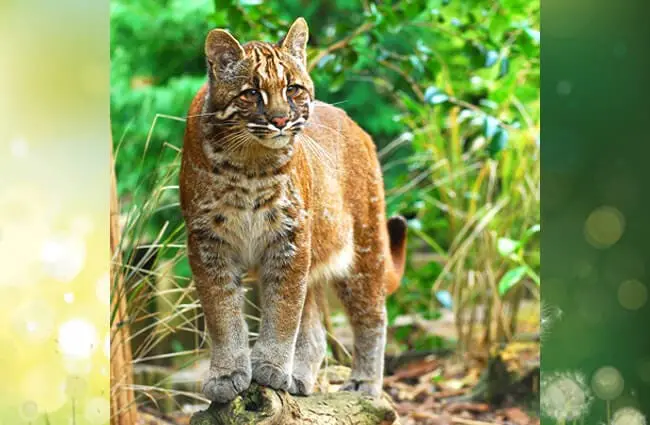The forests of Asia harbor a secret, a feline enigma cloaked in gold. This is the Asian Golden Cat, a medium‑sized wild cat whose beauty and elusiveness have captivated naturalists for decades. Often described as the “holy grail” for wildlife researchers, the Golden Cat remains one of the least studied felids. This guide dives into the world of this remarkable creature, exploring its habitat, behavior, evolution, and conservation status.

Understanding the Golden Cat
Physical Characteristics
The Asian Golden Cat, scientifically known as Catopuma temminckii, is a stunning feline. Its coat exhibits a remarkable range of colors, from a pale golden or reddish‑brown to a slate gray, providing effective camouflage within its diverse habitats. The cat typically weighs between 9 and 16 kilograms, with a body length of 66 to 101 centimeters and a tail adding another 31 to 51 centimeters. Its relatively short legs and long body contribute to its agility in forested environments. A defining feature is its muscular build, hinting at a powerful predator. Distinctive markings can include dark stripes on the forehead and spots on the flanks, although these are often less pronounced in older individuals.
Habitat and Distribution
The Golden Cat’s range stretches across the dense evergreen and deciduous forests, as well as grasslands, of Southeast Asia. It is found in India, Nepal, Bhutan, Thailand, Malaysia, Indonesia, and parts of China. It is primarily found in evergreen and moist deciduous forests but can adapt to a variety of habitats, including subalpine forests and even mangrove swamps. Its preference for forested areas underscores the importance of preserving these ecosystems for the cat’s survival. It generally avoids open areas and heavily disturbed landscapes.

Behavior and Ecology
Diet and Hunting Strategies
The Golden Cat is an opportunistic hunter, and its diet is remarkably diverse. While primarily carnivorous, it consumes a variety of prey. Smaller mammals such as rodents, rabbits, and squirrels form a significant part of its diet. It also preys on birds, reptiles, amphibians, and even fish. Interestingly, it has also been observed consuming fruit and other plant matter. Its hunting strategy is adapted to the dense undergrowth of its habitat, employing stealth and ambush tactics. It is a skillful climber and can pursue prey in trees. While often solitary hunters, observations suggest it sometimes hunts in pairs.
Social Behavior and Reproduction
Much of the Golden Cat’s social behavior remains a mystery due to its elusive nature. It is generally considered solitary, except during mating season or when a mother is raising her young. Little is known about its mating rituals, but it is believed that females may have multiple partners. Gestation is thought to last around 75 to 80 days, resulting in litters of one to three kittens. Kittens are born in sheltered dens, often within hollow logs or rock crevices. The mother provides all the care, and kittens typically remain dependent for several months, learning essential hunting skills before venturing out on their own. Sexual maturity is reached around 18 to 24 months.

Evolution and Taxonomy
Tracing the Golden Cat’s Ancestry
The evolutionary history of the Golden Cat is still being pieced together, but genetic studies suggest it belongs to the Catopuma genus, which also includes the Bay Cat. It is believed to have diverged from other cat lineages several million years ago. Fossil evidence is scarce, making it difficult to pinpoint its exact origins, but the Catopuma genus is thought to have originated in Asia. The Golden Cat’s unique characteristics, such as its coat coloration and skull morphology, distinguish it from other cat species and highlight its evolutionary adaptations to its specific environment.
Genetic Diversity
While no subspecies are currently recognized, some populations in Borneo are distinct and have been proposed as a separate species, Catopuma badia. Further genetic research is needed to clarify the relationships between different populations. Maintaining genetic diversity is crucial for the long‑term survival of the species, as it enhances their ability to adapt to changing environmental conditions.

Golden Cats and Humans
Conservation Status and Threats
The Asian Golden Cat is listed as “Vulnerable” on the IUCN Red List. This designation reflects the numerous threats it faces, including habitat loss and fragmentation due to deforestation and agricultural expansion. Poaching for its skin and body parts, used in traditional medicine, is also a significant concern. Additionally, it is sometimes killed in retaliation for preying on livestock. The reduction in prey availability due to hunting and habitat degradation further exacerbates its vulnerability.
Interactions with Local Communities
Encounters between Golden Cats and humans are relatively rare, due to the cat’s elusive nature and preference for forested habitats. However, in some areas, it may come into conflict with local communities when it preys on poultry or other livestock. Raising awareness among local communities about the importance of conserving Golden Cats and providing compensation for livestock losses can help mitigate these conflicts. Supporting sustainable land‑use practices that protect forested habitats is also crucial.

What to Do If You Encounter a Golden Cat
If you are fortunate enough to encounter a Golden Cat in the wild, it is essential to maintain a respectful distance and avoid disturbing the animal. Do not approach it or attempt to feed it. If the cat appears to be injured or distressed, contact local wildlife authorities. Remember that Golden Cats are wild animals and should be treated with caution.
Further Considerations for Zoologists and Caretakers
Captive Care and Husbandry
Caring for Golden Cats in captivity requires a deep understanding of their natural history and behavioral needs. Enclosures should be spacious and provide a complex environment with plenty of climbing structures, vegetation, and secluded resting areas. Diet should be varied and mimic their natural prey, including small mammals, birds, and reptiles. Enrichment activities, such as puzzle feeders and scent‑marking opportunities, are essential to stimulate their minds and prevent boredom. Careful monitoring of their health and behavior is crucial to ensure their well‑being.
Research Priorities
Despite its beauty and ecological importance, the Golden Cat remains one of the most understudied felids. Future research should focus on clarifying its evolutionary relationships, mapping its distribution, estimating population sizes, and understanding its habitat requirements. Investigating its social behavior, reproductive biology, and diet are also crucial. Long‑term monitoring programs are needed to assess the effectiveness of conservation efforts and adapt management strategies as needed.
The Golden Cat, a phantom of the Asian forests, embodies the mysteries and wonders of the natural world. Its survival depends on our commitment to protecting its habitat and understanding its ecological role. By supporting conservation efforts and promoting responsible land‑use practices, we can ensure that this magnificent feline continues to roam the forests for generations to come.

![Red Angus Closeup of a beautiful Red Angus cowPhoto by: U.S. Department of Agriculture [pubic domain]https://creativecommons.org/licenses/by/2.0/](https://animals.net/wp-content/uploads/2020/03/Red-Angus-4-238x178.jpg)




![Red Angus Closeup of a beautiful Red Angus cowPhoto by: U.S. Department of Agriculture [pubic domain]https://creativecommons.org/licenses/by/2.0/](https://animals.net/wp-content/uploads/2020/03/Red-Angus-4-100x75.jpg)

